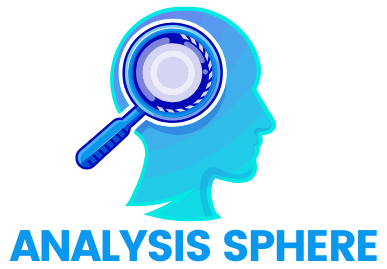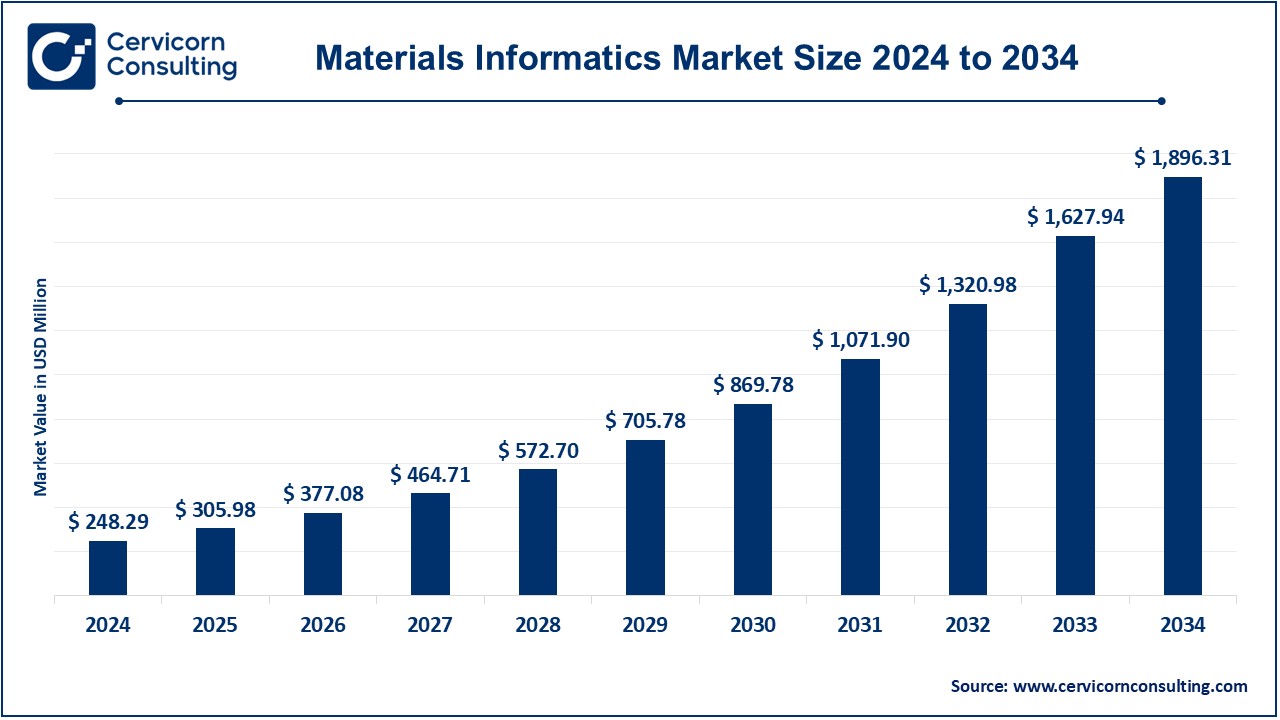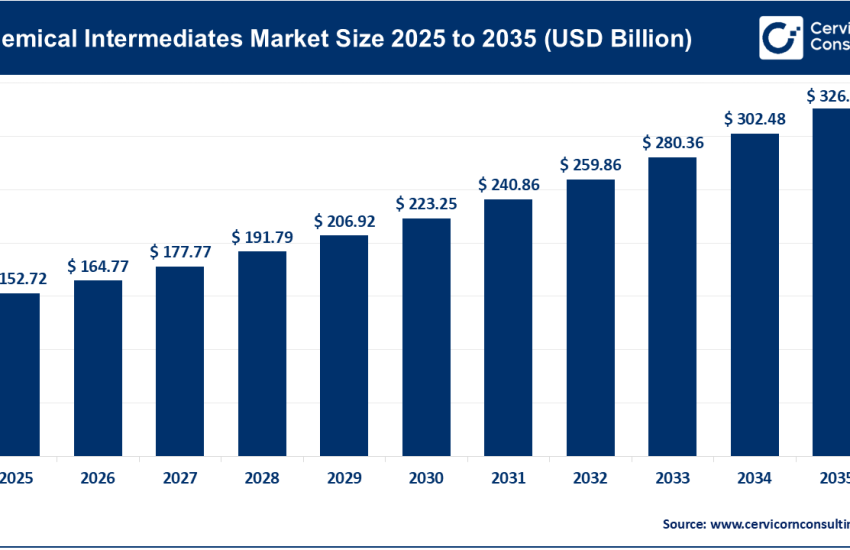Materials Informatics Market Trends, Top Companies, and Insights 2025 – 2034
Materials Informatics Market Overview
The global materials informatics market was valued at USD 248.29 million in 2024 and is projected to reach USD 1,896.31 million by 2034, growing at a compound annual growth rate (CAGR) of 22.54% over the forecast period.
What is the Materials Informatics Market?
The materials informatics market revolves around the use of advanced computational tools and data-driven methodologies to accelerate the discovery, design, and deployment of materials. By integrating machine learning, artificial intelligence (AI), and data analytics with materials science, this market aims to address challenges in various industries, including aerospace, automotive, energy, and healthcare. The field focuses on harnessing vast amounts of data from experiments, simulations, and literature to uncover insights and predict material behaviors more effectively than traditional methods.
Why is the Materials Informatics Market Important?
- Accelerating Innovation: Traditional methods of materials discovery and development are time-intensive and costly. Materials informatics enables researchers and industries to discover new materials in significantly shorter timeframes, thereby reducing R&D costs.
- Sustainability Goals: Industries are increasingly seeking sustainable materials. Materials informatics facilitates the identification of eco-friendly materials, reducing environmental impact and supporting global sustainability initiatives.
- Custom Solutions: With the ability to tailor material properties through data-driven insights, industries can develop specialized solutions for specific applications, enhancing product performance and competitiveness.
- Cost Efficiency: By reducing trial-and-error experimentation, materials informatics minimizes resource consumption, leading to substantial cost savings across industries.
Get a Free Sample: https://www.cervicornconsulting.com/sample/2311
Materials Informatics Market Top Companies
1. Citrine Informatics
- Specialization: AI-driven materials discovery and optimization
- Key Focus Areas:
- Machine learning models for material property prediction
- Cloud-based platform for collaboration and data sharing
- Notable Features:
- Proprietary Citrine™ Platform that integrates AI and domain expertise
- Extensive material datasets
- 2023 Revenue (Approx.): $25 million
- Market Share (Approx.): 15%
- Global Presence: Offices in the US and partnerships across North America, Europe, and Asia-Pacific
2. Materials Zone Ltd.
- Specialization: Materials data management and AI-powered analysis
- Key Focus Areas:
- Automated data structuring and visualization
- Integration with experimental and computational workflows
- Notable Features:
- Platform optimized for academic and industrial research
- Emphasis on accelerating nanotechnology and polymer research
- 2023 Revenue (Approx.): $12 million
- Market Share (Approx.): 8%
- Global Presence: Strong footprint in Israel and expanding operations in Europe and the US
3. BASF
- Specialization: Industrial application of materials informatics
- Key Focus Areas:
- Development of chemicals and materials for agriculture, construction, and automotive industries
- Integration of computational tools in R&D
- Notable Features:
- Extensive in-house data resources
- Collaboration with leading research institutions
- 2023 Revenue (Approx.): $90 billion (Overall BASF revenue; materials informatics segment proportion undisclosed)
- Market Share (Approx.): 20% (in the materials informatics domain)
- Global Presence: Operating in over 90 countries, with a strong focus on Europe, North America, and Asia-Pacific
4. Kebotix
- Specialization: Autonomous R&D powered by AI and robotics
- Key Focus Areas:
- Discovery of sustainable materials
- Automated laboratories for faster experimentation
- Notable Features:
- Unique “self-driving lab” concept
- AI algorithms integrated with robotic automation
- 2023 Revenue (Approx.): $18 million
- Market Share (Approx.): 12%
- Global Presence: Based in the US with collaborations worldwide
5. AI Materia
- Specialization: AI-powered materials research and development
- Key Focus Areas:
- Predictive modeling for material performance
- Optimization of material properties for specific applications
- Notable Features:
- Cloud-based AI tools tailored for industrial use
- Collaboration with global industrial leaders
- 2023 Revenue (Approx.): $10 million
- Market Share (Approx.): 7%
- Global Presence: Growing presence in Europe and North America, with partnerships in Asia-Pacific
Materials Informatics Market Leading Trends and Their Impact
1. Integration of AI and Machine Learning
- Impact: The incorporation of AI in materials informatics has revolutionized the field by enabling predictive modeling and high-throughput screening. This trend reduces development cycles and increases accuracy in predicting material behaviors.
2. Emphasis on Sustainable Materials
- Impact: Governments and industries are prioritizing sustainable practices. Materials informatics facilitates the discovery of biodegradable polymers, recyclable metals, and low-carbon materials, supporting green initiatives globally.
3. Adoption of Cloud-Based Platforms
- Impact: Cloud computing has enabled seamless collaboration among global teams. Cloud-based solutions offer scalability, real-time data sharing, and integration of computational tools, driving innovation in materials research.
4. Collaborative Ecosystems
- Impact: Partnerships between academia, industry, and technology providers are fostering open innovation. Shared data repositories and collaborative research accelerate progress in diverse applications.
5. Regional Focus on Advanced Manufacturing
- Impact: Materials informatics is playing a pivotal role in supporting advanced manufacturing processes, such as additive manufacturing (3D printing), by optimizing material properties for specific applications.
Regional Analysis Including Government Initiatives and Policies
North America
Key Countries: United States, Canada
Government Initiatives:
- The US Department of Energy (DOE) funds projects integrating AI with materials science to advance clean energy technologies.
- Canada’s National Research Council supports research in materials informatics to bolster its manufacturing and energy sectors.
Market Impact:
- Dominance in the aerospace and automotive sectors drives demand for advanced materials. North America accounts for approximately 35% of the global market share.
Europe
Key Countries: Germany, UK, France
Government Initiatives:
- The European Union’s Horizon Europe program funds projects focused on AI in materials science, emphasizing sustainability.
- Germany’s Fraunhofer Institutes lead collaborative research in materials informatics.
Market Impact:
- Europe is a leader in sustainable materials research. Strong regulatory frameworks and funding initiatives position the region as a hub for innovation.
Asia-Pacific
Key Countries: China, Japan, South Korea, India
Government Initiatives:
- China’s “Made in China 2025” policy includes a focus on advanced materials for high-tech industries.
- Japan and South Korea invest heavily in AI-driven R&D for materials in electronics and semiconductors.
Market Impact:
- Asia-Pacific is the fastest-growing region in the materials informatics market, driven by strong industrial bases and increasing investments in technology.
Latin America
Key Countries: Brazil, Mexico
Government Initiatives:
National programs supporting nanotechnology and advanced materials research.
Market Impact:
Growth in the region is supported by demand for advanced materials in agriculture and energy sectors.
Middle East and Africa
Key Countries: UAE, South Africa
Government Initiatives:
- Investments in renewable energy projects drive the need for advanced materials.
Market Impact:
- A growing focus on infrastructure and energy applications fuels the adoption of materials informatics in the region.
To Get Detailed Overview, Contact Us: https://www.cervicornconsulting.com/contact-us
Read Report: Coated Fabrics Market Growth, Key Players, & Trends 2023-2033



